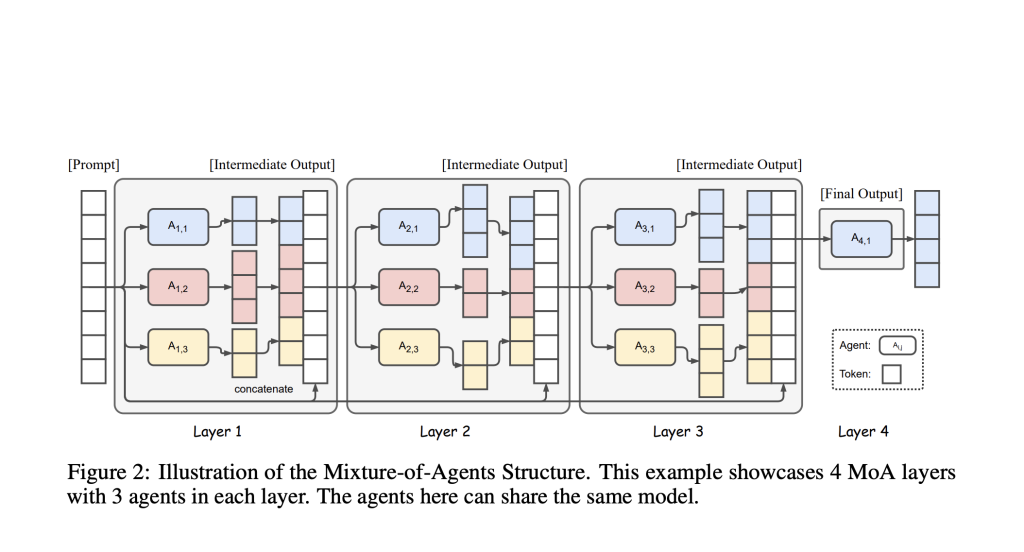The Mixture-of-Agents (MoA) architecture is a transformative approach for enhancing large language model (LLM) performance, especially on complex, open-ended tasks where a single model can struggle with accuracy, reasoning, or domain specificity.
How the Mixture-of-Agents Architecture Works
- Layered Structure: MoA frameworks organize multiple specialized LLM agents in layers. Each agent within a layer receives all outputs from agents in the previous layer as context for its own response—this promotes richer, more informed outputs.
- Agent Specialization: Each agent can be tailored or fine-tuned for specific domains or problem types (e.g., law, medicine, finance, coding), acting similarly to a team of experts, each contributing unique insights.
- Collaborative Information Synthesis: The process starts with a prompt being distributed among proposer agents who each offer possible answers. Their collective outputs are aggregated, refined, and synthesized by subsequent layers (with “aggregator” agents), gradually creating a single, comprehensive, high-quality result.
- Continuous Refinement: By passing responses across multiple layers, the system iteratively improves reasoning depth, consistency, and accuracy—analogous to human expert panels reviewing and enhancing a proposal.

Why Is MoA Superior to Single-Model LLMs?
- Higher Performance: MoA systems have recently outperformed leading single models (like GPT-4 Omni) on competitive LLM evaluation benchmarks, achieving, for example, 65.1% on AlpacaEval 2.0 versus GPT-4 Omni’s 57.5%—using only open-source LLMs.
- Better Handling of Complex, Multi-Step Tasks: Delegating subtasks to agents with domain-specific expertise enables nuanced, reliable responses even on intricate requests. This addresses key limitations of “jack-of-all-trades” models.
- Scalability and Adaptability: New agents can be added or existing ones retrained to address emerging needs, making the system more agile than retraining a monolithic model on every update.
- Error Reduction: By giving each agent a narrower focus and using an orchestrator to coordinate outputs, MoA architectures lower the likelihood of mistakes and misinterpretation—boosting both reliability and interpretability.
Real-World Analogy and Applications
Imagine a medical diagnosis: one agent specializes in radiology, another in genomics, a third in pharmaceutical treatments. Each reviews a patient’s case from its own angle. Their conclusions are integrated and weighted, with higher-level aggregators assembling the best treatment recommendation. This approach is now being adapted to AI for everything from scientific analysis to financial planning, law, and complex document generation.
Key Takeaways
- Collective Intelligence Over Monolithic AI: The MoA architecture leverages the collective strengths of specialized agents, producing results that surpass single, generalist models.
- SOTA Results and Open Research Frontier: The best MoA models are setting state-of-the-art results on industry benchmarks and are the focus of active research, pushing AI’s capability frontier forward.
- Transformative Potential: From critical enterprise applications to research assistants and domain-specific automation, the MoA trend is reshaping what is possible with AI agents.
In summary, combining specialized AI agents—each with domain-specific expertise—through MoA architectures leads to more reliable, nuanced, and accurate outputs than any single LLM, especially for sophisticated, multi-dimensional tasks.
Source:
- https://docs.together.ai/docs/mixture-of-agents
- https://arxiv.org/abs/2406.04692
- https://www.lyzr.ai/blog/mixture-of-expert-agents/
- https://www.ema.co/additional-blogs/addition-blogs/mixture-of-agents-enhancing-large-language-model-capabilities
- https://blog.tai.com.np/mixture-of-agents-enhancing-large-language-model-capabilities-through-collaboration-703bfafde151
- https://zilliz.com/blog/mixture-of-agents-how-collective-intelligence-elevates-llm-performance
- https://arxiv.org/html/2406.04692v1
- https://openreview.net/forum?id=ioprnwVrDH
- https://weaviate.io/papers/moa
- https://towardsdatascience.com/moe-moa-for-large-language-models-c1cafeffd6a5/
The post Mixture-of-Agents (MoA): A Breakthrough in LLM Performance appeared first on MarkTechPost.
Source: Read MoreÂ


